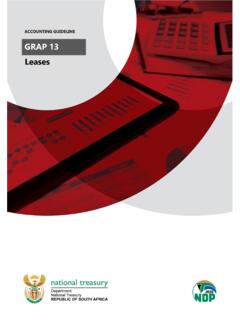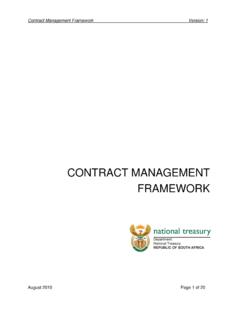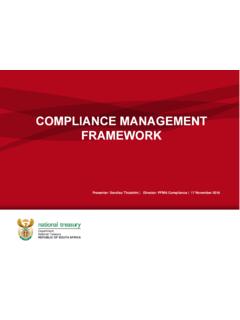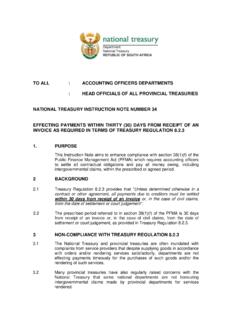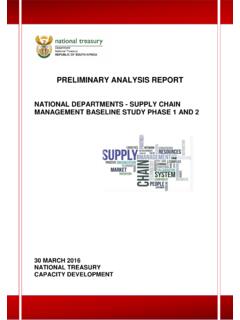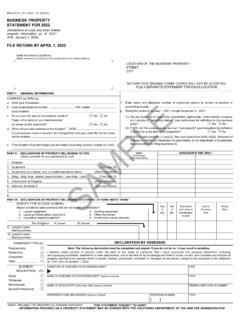Transcription of BAS AND THE Chapter 2 STANDARD CHART OF ACCOUNTS
1 Basic Accounting Handbook for Government Departments BAS AND THE STANDARD CHART OF ACCOUNTS Chapter 2 July 2010 2 Contents 1. Overview .. 3 2. Key learning objectives .. 3 3. Understanding the STANDARD CHART of ACCOUNTS .. 4 4. Understanding the Economic Classification .. 12 5. About the Basic Accounting System (BAS) .. 16 6. The Payments Process .. 17 PERSAL .. 18 LOGIS .. 21 MEDSAS .. 23 Debit Orders .. 24 Credit transfers and manual payments .. 25 Sundry 26 7. Methods of Payment .. 27 Electronic Fund Transfers (EFT) .. 28 Cheque Payments .. 28 Cash Payments .. 28 Petty Cash .. 29 8. Reconciliations .. 30 9. The Receipting Process .. 31 Direct Deposits .. 31 The Receipting Process for Departmental Own Revenue.
2 32 Annexure 1: BAS Processing Rules .. 37 Annexure 2: Understanding the BAS Trial Balance .. 39 Annexure 3: BAS and the SCoA Segments .. 42 3 1. Overview The purpose of the Chapter is to provide a basic understanding of how the STANDARD CHART of ACCOUNTS (SCoA) is structured and how the Basic Accounting System (BAS) is organised to facilitate transaction processing and reporting. This Chapter draws on information from the Training Guide to the STANDARD CHART of ACCOUNTS which was issued at the SCoA training sessions and the BAS Training Guide, a detailed guide on how to utilise the Basic Accounting System (see reference guide to the Accounting Handbook on where to access these guidelines).
3 In this Chapter expenditure transactions are described as payments and revenue transactions as receipts as the terms are applicable to the current accounting environment. A list of item descriptions for the various ACCOUNTS referred to in the examples, are provided in an annexure to the Chapter . The Office of the Accountant-General compiles an annual Departmental Financial Reporting Framework (ADFRF), commonly referred to as the AFS Prep Guide, which is referred to throughout the Chapter . 2. Key learning objectives Understand the composition of the SCoA Understand the BAS General Ledger and sub-systems where transactions are initiated Understand the payments transaction processing and capture in BAS Understand the receipts transaction processing and capture in BAS 4 3.
4 Understanding the STANDARD CHART of ACCOUNTS The SCoA is the system by which financial transactions are recorded in BAS. The coding structure comprises seven segments. When recording a transaction, a selection must be made from each of the seven segments, meaning that all segments must be used for recording a single transaction. The diagram below illustrates this principle: TransactionProject SegmentObjective SegmentFund SegmentItem SegmentAsset SegmentResponsibility SegmentRegional SegmentDoes the transaction relate to a specific project and if so, what type of project?Against which programme/activity should the transaction be recorded?Against which source of funding is the payment allocated, and against which source is revenue received?
5 What is being bought and what is the nature of the receipt?To which cost centre should the transaction be allocated?Does the transaction relate to an asset or the use of an asset and if so, which class of asset?In which region does the service get delivered and in which region is the beneficiary that benefits from the transaction? When establishing the appropriate classification code from a segment the following questions provided in the diagram above need to be answered. Each segment is explained in more detail below: Fund segment Purpose: To identify the various sources of funding available to departments for financing expenditure relating departmental operations. The fund segment is also used to record receipts collected by departments for the rendering of services, delivery of goods and other funds received within the normal course of operations.
6 5 The assets and liabilities section in the fund segment provides for interdepartmental transactions at the national and provincial level and transactions relating to assets and liabilities. Voted funds are the main source of funds available to departments. These funds can be accessed through the annual appropriation by Parliament/Legislature per the Appropriation Act and the Adjusted Appropriation Act and are used to finance the annual operating activities of the department. conditional grants are allocations to provinces and municipalities from national government s share of nationally raised revenue, which are conditional on certain services being delivered or on compliance with specified requirements.
7 The picture below illustrates the flow and utilisation of appropriated funds: A Provincial Department of Public Works purchased bricks for the construction of a new hospital in Elundini. The invoice is paid using voted funds and is allocated against Programme 2 Public Works and the Ukhahlamba Region cost centre. Against which fund will this transaction be allocated? Response: Voted Funds National Department Provincial Government Suppliers/Service Providers Individuals/ Entities Voted Funds conditional Grants Voted Funds Sale of Goods & Services 6 Objective segment Purpose: To identify the programme/activity against which any given transaction should be recorded. In terms of the requirements of the Public Finance Management Act (PFMA), funds are appropriated by programme (or main division within a vote).
8 The objective segment reflects a department s programme and sub-programme structure in as much detail as required both for reporting and management purposes. A Provincial Department of Public Works purchased bricks for the construction of a new hospital in Elundini. The invoice is paid using voted funds and is allocated against Programme 2 Public Works and the Ukhahlamba Region cost centre. Against which objective will this transaction be allocated? Response: Public Works (sub-programme) Responsibility segment Purpose: To provide for the organisational allocation of cost incurred according to cost centres within the department. The responsibility segment identifies the particular unit of the organisation, such as an office, a school or a hospital clinic.
9 Normally it includes a responsibility manager, and a group of employees, who are responsible for certain activities. Responsibilities are components or groups of components from the departmental organogram. In many cases responsibilities are designed in close connection with programmes, sub-programmes and objectives. The Responsibility segment is the only remaining non-standardised segment. This is because the responsibilities are identified according to the needs of the department. 7 A Provincial Department of Public Works purchased bricks for the construction of a new hospital in Elundini. The invoice is paid using voted funds and is allocated against Programme 2 Public Works and the Ukhahlamba Region cost centre.
10 Against which responsibility will this transaction be allocated? Response: Ukhahlamba Region (Chief Directorate responsible for the Ukhahlamba Region) Item segment Purpose: To record receipt and payment items as well as transactions in assets and liabilities. The item segment identifies the goods, services and other payments to be made in achieving the objective of a department, also commonly referred to as the what government is paying for. The payment categories show what has been bought; or to whom funds have been transferred. Receipts are also classified according to the nature of goods/ services rendered. A Provincial Department of Public Works purchased bricks for the construction of a new hospital in Elundini.
